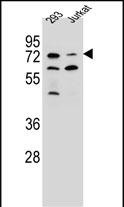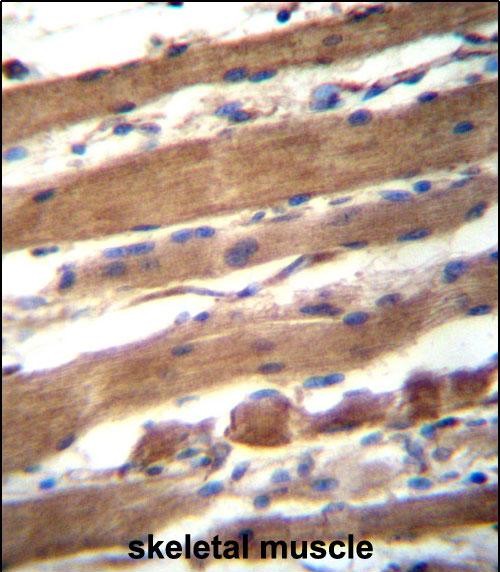SLC9A6 Antibody (C-term)
Affinity Purified Rabbit Polyclonal Antibody (Pab)
- SPECIFICATION
- CITATIONS
- PROTOCOLS
- BACKGROUND

Application
| WB, IHC-P, E |
|---|---|
| Primary Accession | Q92581 |
| Other Accession | NP_006350.1 |
| Reactivity | Human |
| Host | Rabbit |
| Clonality | Polyclonal |
| Isotype | Rabbit IgG |
| Calculated MW | 77917 Da |
| Antigen Region | 501-530 aa |
| Gene ID | 10479 |
|---|---|
| Other Names | Sodium/hydrogen exchanger 6, Na(+)/H(+) exchanger 6, NHE-6, Solute carrier family 9 member 6, SLC9A6, KIAA0267, NHE6 |
| Target/Specificity | This SLC9A6 antibody is generated from rabbits immunized with a KLH conjugated synthetic peptide between 501-530 amino acids from the C-terminal region of human SLC9A6. |
| Dilution | WB~~1:1000 IHC-P~~1:10~50 E~~Use at an assay dependent concentration. |
| Format | Purified polyclonal antibody supplied in PBS with 0.09% (W/V) sodium azide. This antibody is purified through a protein A column, followed by peptide affinity purification. |
| Storage | Maintain refrigerated at 2-8°C for up to 2 weeks. For long term storage store at -20°C in small aliquots to prevent freeze-thaw cycles. |
| Precautions | SLC9A6 Antibody (C-term) is for research use only and not for use in diagnostic or therapeutic procedures. |
| Name | SLC9A6 (HGNC:11079) |
|---|---|
| Synonyms | KIAA0267, NHE6 |
| Function | Endosomal Na(+), K(+)/H(+) antiporter (PubMed:15522866, PubMed:28635961, PubMed:31676550, PubMed:32277048). Mediates the electroneutral exchange of endosomal luminal H(+) for a cytosolic Na(+) or K(+). By facilitating proton efflux, SLC9A6 counteracts the acidity generated by vacuolar (V)-ATPase, thereby limiting luminal acidification. Responsible for alkalizing and maintaining the endosomal pH, and consequently in, e.g., endosome maturation and trafficking of recycling endosomal cargo (PubMed:15522866, PubMed:28635961, PubMed:31676550, PubMed:32277048). Plays a critical role during neurodevelopment by regulating synaptic development and plasticity (By similarity). Implicated in the maintenance of cell polarity in a manner that is dependent on its ability to modulate intravesicular pH (PubMed:20130086). Regulates intracelular pH in some specialized cells, osteoclasts and stereocilia where this transporter localizes to the plasma membrane (By similarity). |
| Cellular Location | Endosome membrane; Multi-pass membrane protein. Recycling endosome membrane; Multi-pass membrane protein. Early endosome membrane; Multi-pass membrane protein. Late endosome membrane; Multi-pass membrane protein. Cell membrane; Multi-pass membrane protein. Note=Present predominantly in the recycling compartments including early and recycling endosomes, but undergoes plasma membrane localization during vesicular recycling, which is enhanced upon certain stimuli, such as hypoxia (PubMed:11940519, PubMed:28635961, PubMed:30296617). Has a major plasmalemmal distribution in a few specialized cells, such as in vestibular hair bundles and osteoblasts (By similarity) {ECO:0000250|UniProtKB:A1L3P4, ECO:0000269|PubMed:11940519, ECO:0000269|PubMed:28635961, ECO:0000269|PubMed:30296617} |
| Tissue Location | Ubiquitous. High expression in brain, skeletal muscle, and heart, but is also detected at lower levels in most other tissues. |

Thousands of laboratories across the world have published research that depended on the performance of antibodies from Abcepta to advance their research. Check out links to articles that cite our products in major peer-reviewed journals, organized by research category.
info@abcepta.com, and receive a free "I Love Antibodies" mug.
Provided below are standard protocols that you may find useful for product applications.
Background
This gene encodes a sodium-hydrogen exchanger that is amember of the solute carrier family 9. The encoded protein localizes to early and recycling endosomes and may be involved in regulating endosomal pH and volume. Defects in this gene are associated with X-linked syndromic mental retardation, Christianson type. Alternate splicing results in multiple transcript variants.
References
Garbern, J.Y., et al. Brain 133 (PT 5), 1391-1402 (2010) :
Ohgaki, R., et al. Mol. Biol. Cell 21(7):1293-1304(2010)
Fukura, N., et al. J. Membr. Biol. 234(3):149-158(2010)
Fichou, Y., et al. Eur. J. Hum. Genet. 17(11):1378-1380(2009)
Roxrud, I., et al. Exp. Cell Res. 315(17):3014-3027(2009)
If you have used an Abcepta product and would like to share how it has performed, please click on the "Submit Review" button and provide the requested information. Our staff will examine and post your review and contact you if needed.
If you have any additional inquiries please email technical services at tech@abcepta.com.













 Foundational characteristics of cancer include proliferation, angiogenesis, migration, evasion of apoptosis, and cellular immortality. Find key markers for these cellular processes and antibodies to detect them.
Foundational characteristics of cancer include proliferation, angiogenesis, migration, evasion of apoptosis, and cellular immortality. Find key markers for these cellular processes and antibodies to detect them. The SUMOplot™ Analysis Program predicts and scores sumoylation sites in your protein. SUMOylation is a post-translational modification involved in various cellular processes, such as nuclear-cytosolic transport, transcriptional regulation, apoptosis, protein stability, response to stress, and progression through the cell cycle.
The SUMOplot™ Analysis Program predicts and scores sumoylation sites in your protein. SUMOylation is a post-translational modification involved in various cellular processes, such as nuclear-cytosolic transport, transcriptional regulation, apoptosis, protein stability, response to stress, and progression through the cell cycle. The Autophagy Receptor Motif Plotter predicts and scores autophagy receptor binding sites in your protein. Identifying proteins connected to this pathway is critical to understanding the role of autophagy in physiological as well as pathological processes such as development, differentiation, neurodegenerative diseases, stress, infection, and cancer.
The Autophagy Receptor Motif Plotter predicts and scores autophagy receptor binding sites in your protein. Identifying proteins connected to this pathway is critical to understanding the role of autophagy in physiological as well as pathological processes such as development, differentiation, neurodegenerative diseases, stress, infection, and cancer.



